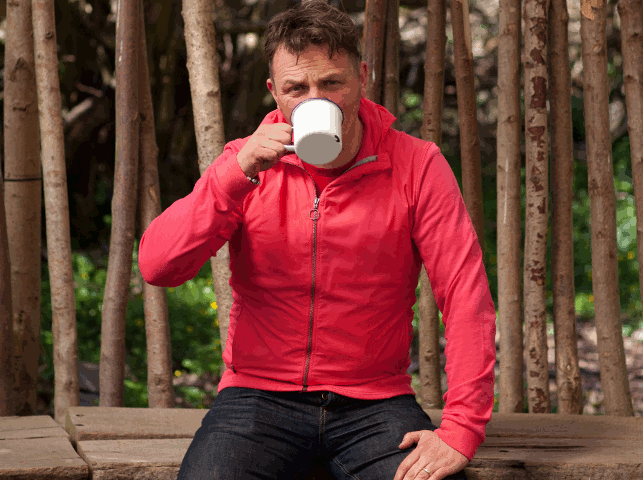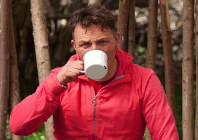Why did you become a designer?
I didn’t have any choice. I wanted to change things and therefore had to become a designer.
I graduated in environmental science but soon realised that the thing that interested me was the way people use products and services, the way they behave, and the way that society has become obsessed with owning things at the detriment to doing things. So, I learnt about design.

Mark Shayler
Which designer or company do you most admire and why?
I genuinely don’t have heroes. Well, apart from Daley Thompson. I admire many companies for many different reasons: Lamy for the design of the Safari pen; Black and White (makers of a hair pomade) for the fragrance they add to their product; Dr Martens for being my friend since I was six; Braun for having the confidence to launch subtle and beautifully design products; Hiut Denim for making the best jeans in the world (the SlimR) and aiming to get a town making jeans again; Vivienne Westwood for ruffling feathers and setting tartan free; Opinel for making a knife that feels as good in the pocket as it does in the hand; Apple for their OS and iOS design (not the products), and Pilot for the fineliner pen.
What product couldn’t you live without?
There is no product that I couldn’t live without. Need and want are very different things and if we have food, shelter, warmth and love then that’s enough surely? That said I would be lost without a bike and good knife — no particular brand.
What design would you have loved to have designed and why?
I’d love to have designed the safety bike (the first real bicycle). It stopped interbreeding, allowed people to travel further than 20 miles in a day, and still fills me with delight aged 45.
Play-Doh, Meccano or Lego?
I’m a child of the 70s so all three. In the days before four TV channels let alone the internet, making things and imagining was all we could do with our time. Boredom is a good motivator to get off your arse and do something. If you’ve got Lego (or Meccano or Play-Doh) then you’ve got every toy in the world.
What are your weapons of choice?
My eyes, a pilot fineliner, Keynote, a laptop, and my brain. But you never do your best work at your desk so I’d also say my feet.
What is missing from your toolset?
Too many to mention. Always be learning.
Is there anything that would make your design and development process run smoother?
Yes, having a process would help. I tried to map my process in my book ‘Do Disrupt: Change the Status Quo or Become it’ and in so doing realised that I help other people apply the process but often forget to apply it in my own work.
What’s the most annoying thing you’ve discovered about a product you’ve dissected?
Most products I take apart have been designed by an accountant rather than a designer. Cost and value have been confused. We know the price of everything and the value of nothing and accountants rule the world. It’s bloody depressing.
I see the inside of things. I see the end of things. I see products that are less than a year old failing. How must that make designers feel?
How did you find sustainability as a passion?
It found me. As soon as I understood that the word eco is shared with economy and that it comes from the Greek ‘Oikos’ for home I realised that it’s not about the environment, rather that we are the environment. This isn’t about being a hippy, it’s about being happy without being selfish.
What would you say is the biggest challenge facing designers?
Where to begin? There are so many problems and challenges, which all bring their own opportunities too.
The predicted move of three billion people from working to middle-class by 2030 will create significant resource, economic and environmental challenges. The ‘bourgeoisification’ of society will mean that we need to do more with less, will need to design products better so that they use less resources, last longer and are driven by different ways of making money.
The future is in the East. China and Africa won’t just make things they will design them too and so there is an impending crisis in the design world as the centre of gravity of design innovation moves East.
Then we have the shift from product to service. This is a good challenge; we need to redesign user experiences.
It will be less about products and more about the way we use them. Less about ownership and more about membership. Less about thoughtless consumption and more about thoughtful consumption. This requires a different set of design skills that we need to develop super-quickly.
Can you predict any future trends?
We will see a return of manufacturing to Europe and the US but it will take the near economic collapse of the consumer society first. We own twice as much stuff as we did in the 70s but are no happier. This is scary stuff.
We will also see a return of practical skills, of apprenticeships, of making. This will be a beautiful blend of the traditional and the modern.
If you were hosting a dinner party who would you invite and why?
My old mate Steve Manifold who is one of the funniest people I’ve ever met. Banksy so he could doodle on some napkins. James Victore because he is a great and inspirational guy. Elvis circa 1960 so I could introduce him to the paleo diet.
Daley Thompson — no explanation required. Jesse Owens because he humiliated Hitler at the 1936 Olympic Games. Nelson Mandela because he didn’t just show racism was wrong, he showed it was irrelevant. Dick Fosbury because he created a new way to jump. My wife Nicola who makes my heart beat faster with just a look. David Attenborough because he knows things. My nan because she’s 90 and doesn’t get out very often.
Do you want gravy with your burger?
After a visit to Speedys cafe in Euston with Al Dean I don’t ever want gravy with my burger again. When I see burger on the menu I expect a bun. That was a funny lunch. Funny because the food was odd and funny because we didn’t stop laughing from when we met to when we said goodbye. But we should have gone to Diwana on Drummond Street.
Let’s talk about the shoe problem…
Life is too short for boring shoes. I stand on the platform at Tamworth train station and see a sea of boring shoes. I look down at my own and see leopard skin creepers or gold pumas or pastel blue kickers or handmade Northampton brogues or white docs and I know it’ll be a great day.

My friend Steve Edge says “dress every day for a party and the party comes to you”. He’s right. Wear great shoes, be nice to people, work hard, remember to play, live well, ride your bike, do yoga, talk to people and life will be sweet.
Mark Shayler, eco designer and founder of environmental consultancy Tickety Boo
Default






